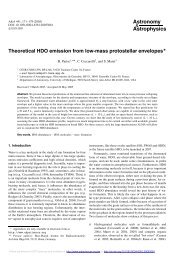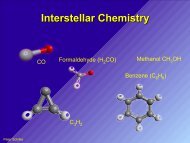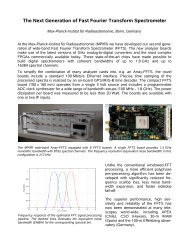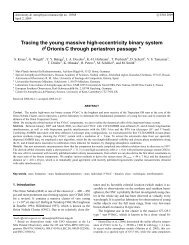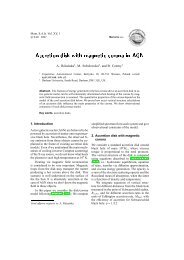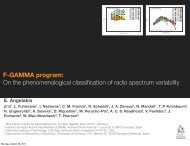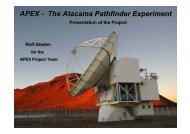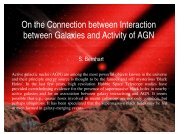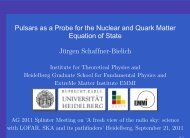Eddington luminosity - Mpifr-bonn.mpg.de
Eddington luminosity - Mpifr-bonn.mpg.de
Eddington luminosity - Mpifr-bonn.mpg.de
You also want an ePaper? Increase the reach of your titles
YUMPU automatically turns print PDFs into web optimized ePapers that Google loves.
Accretion<br />
Let us compute the total available energy.<br />
Consi<strong>de</strong>ring a proton falling in from infinity, we can write<br />
(Longair p. 134)<br />
½ m v 2 free-fall =<br />
G M m<br />
r<br />
When the matter reaches the surface of the star at r=R,<br />
the kinetic energy of the free-fall (part of it) has to be radiated<br />
away as heat.
If the rate at which mass is accreted onto the star is d m/dt,<br />
the rate at which kinetic energy is dissipated at the star surface is<br />
½ dm/dt v^2,<br />
and hence the <strong>luminosity</strong> of the source is<br />
G M dm/dt<br />
L = ½ dm/dt v 2 = c 2<br />
free-fall<br />
R<br />
--<br />
c 2<br />
Accretion efficiency<br />
Efficiency = η = GM / c 2 R<br />
LUMINOSITY =<br />
L = η dm/dt c 2
LUMINOSITY =<br />
L = η dm/dt c 2<br />
R sch =<br />
2GM/c 2<br />
Efficiency = η = GM / c 2 R= ½ R sch<br />
/ R<br />
This is a remarkable formula .<br />
It can be seen that written in this form η is the efficiency of conversion of<br />
the rest mass energy of the accreted matter into heat .<br />
According to the above calculation, the efficiency of energy conversion<br />
simply <strong>de</strong>pends upon how compact the star is.<br />
Thus , accretion is a powerful source of energy. This efficiency of energy<br />
conversion can be compared with the η of nuclear energy generation.
This efficency of energy conversion can be compared with the<br />
nuclear energy generation.<br />
η of<br />
Accretion process: Efficiency = η = GM / c 2 R<br />
Neutron Star – r in<br />
~ 10 km η= 0.1 ---------------------------> 10%<br />
( ..of the rest mass energy of the accreted matter into heat) .<br />
Nuclear fusion process:<br />
Efficiency = η = (4 m p<br />
-m α<br />
) / 4 m p<br />
α<br />
(4 x 1.6726 10 -24 - 6.642 x 10 -24 )<br />
= 0.007<br />
4 x 1.6726 10 -24<br />
For nuclear reactions in stars η ~ 0.007 ----------------------->
Accretion efficiency<br />
Efficiency = η = GM / c 2 R= ½ r sch<br />
/ R<br />
r sch = 2 GM/c 2<br />
White dwarf M=1 M sol, R=5000 Km η= 3 x 10 -4<br />
Neutron Star – r in<br />
~ 10 km η= 0.1<br />
Black Hole - r in<br />
= 3rs η ~ 0.06<br />
But from GR for rotating black holes η = 0.42--------------> >40%<br />
For nuclear reactions in stars η ~ 0.007 ----------------------->
Outward angular momentum<br />
transport<br />
Ring A moves faster than ring B.<br />
Friction between the two will try<br />
to slow down A and speed up B.<br />
Keplerian rotation<br />
A<br />
B<br />
So ring A must move inward! Ring B moves outward, unless it,<br />
too, has friction (with a ring C, which has friction with D, etc.).
The “standard mo<strong>de</strong>l”…<br />
Viscous accretion disks<br />
<br />
<br />
Suppose that there is some kind of “viscosity” in the<br />
disk<br />
− Different annuli of the disk rub against each other and<br />
−<br />
−<br />
exchange angular momentum<br />
Results in most of the matter moving inwards and<br />
eventually accreting<br />
Angular momentum carried outwards by a small amount of<br />
material<br />
Process producing this “viscosity” might also be<br />
dissipative… could turn gravitational potential energy<br />
into heat (and eventually radiation)
Standard Accretion Disk Mo<strong>de</strong>l (Shakura<br />
and Sunyaev 1973) : α<br />
MRI (Balbus and Hawley 1991) can generate<br />
magnetic turbulence and enhance the<br />
efficiency of angular momentum transport
State Transition in Accretion<br />
Disks<br />
<br />
Optically thick, geometrically thin disk<br />
(high/soft)<br />
X-ray intensity<br />
rad =<br />
• Optically thin disk ( low/hard)<br />
energy<br />
X-ray intensity<br />
adv.<br />
energy
<strong>Eddington</strong> Limit<br />
Radiation coming from the disk carries radiation pressure.<br />
Radiation pressure is felt by accreting matter --<br />
eventually radiation pressure becomes higher than gravitational pull of compact<br />
object/star and accretion stops.<br />
Radiation pressure force will be proportional to <strong>luminosity</strong> (more photons=more<br />
radiation pressure)<br />
The limiting <strong>luminosity</strong> at which an object can accrete is:<br />
4 πGMm p<br />
σ Τ<br />
= Thomson cross section<br />
L edd<br />
=<br />
σ T<br />
Derived D for spherical accretion but approximately correct also for accretion disk
Obtain Ledd by setting<br />
Fgrav=Frad<br />
Fgrav (gravitational force per electron) = GM (m p<br />
+m e<br />
) /r2 ~ GM m p<br />
/r 2<br />
Frad = (Number photons x Thompson cross-section) x p<br />
Energy of typical photon = hν<br />
The number of photons crossing unit area in unit time at radius r is:<br />
L/ hν 4πr 2<br />
Number of collisions per electron per unit time= L σ T / hν 4πr 2<br />
Each photon gives a momentum p= hν /c to the electron in each collison<br />
Frad = Lσ T<br />
/ hν 4πr 2 x p = Lσ T<br />
/4πr 2 c<br />
(The radiation pressure acts upon the electrons, however protons and<br />
electrons coupled by Coulomb interaction)<br />
O
Obtain Ledd by setting Fgrav=Frad<br />
Fgrav = GM m p<br />
/r 2<br />
Frad = Lσ T<br />
/4πr 2 c<br />
Ledd σ T<br />
/4πr 2 c = GM m p<br />
/r 2<br />
Ledd<br />
= 4πc G M m p<br />
/σ T<br />
L edd<br />
= 1.3 1038 M/M 0<br />
erg/sec
X-ray binary luminosities<br />
<br />
X-ray binaries typically have<br />
L X<br />
Supermassive BH<br />
L edd = 1.3 1038 M/M 0<br />
erg/sec<br />
Ledd/L 0<br />
=10 5 M/M 0<br />
for M/M 0<br />
in the range<br />
of 10 6-8 M/M 0<br />
Ledd/L0 10 11-13
m p<br />
a p<br />
a p<br />
a s<br />
V<br />
m s<br />
P 2 =<br />
4π 2 (a s<br />
+ a p<br />
) 3<br />
G(m s<br />
+ m p<br />
)
Measuring Masses of Compact Objects<br />
Dynamical study: compact object x<br />
and companion star c<br />
(for binary period, P, and inclination angle, i )<br />
Kepler’s 3 rd Law: 4 π 2 (a x<br />
+ a c<br />
) 3 = GP 2 (M x<br />
+ M c<br />
)<br />
center of mass: M x<br />
a x<br />
= M c<br />
a c<br />
radial velocity amplitu<strong>de</strong> K c<br />
= 2 π a c<br />
sin i P -1<br />
“Mass Function”: f(M) = P K3 / 2πG = M x<br />
sin 3 (i) / (1 + M c<br />
/M x<br />
) 2 < M x<br />
Dynamical Black Hole: M x<br />
> 3 M o<br />
(maximum for a neutron star)<br />
BH Candidates: no pulsations + no X-ray bursts + properties of BHBs
Doppler shifts<br />
Doppler shifts of the spectral lines yield the<br />
radial (i.e. toward the observer) velocity of<br />
the star<br />
z= λ o b s − λ rest<br />
λ rest<br />
= Δλ<br />
λ rest<br />
v r<br />
c<br />
≈z if z
Spectroscopic binaries: circular orbits<br />
•If the orbit is in the plane of the sky (i=0) we observe no radial velocity.<br />
•Otherwise the radial velocities are a sinusoidal function of time. The<br />
minimum and maximum velocities (about the centre of mass velocity)<br />
are given by<br />
m<br />
v ax 1r = v 1 sini<br />
m ax = v 2<br />
sini<br />
v 2r
Elliptical Orbits<br />
O<br />
eccentricity<br />
= OF1/a
Radial velocity shape as a function of eccentricity:
Eccentric orbit can sometimes escape <strong>de</strong>tection:<br />
With poor sampling this star would be consi<strong>de</strong>red constant
Mass Function
“It is worth mentioning here that the accumulation of accreted material on the<br />
surface of a neutron star triggers thermonuclear bursts. These are called bursts of<br />
Type I.<br />
No Type I burst has ever been observed from a compact object where optical<br />
observations resulted in a mass above 3 M⊙.<br />
That fact might confirm that in black holes there is no surface where material<br />
can accumulate “(Narayan & Heyl 2002).<br />
Observations of Type I bursts give a direct evi<strong>de</strong>nce for a neutron star.
Compact Object Mass<br />
Neutron Star Limit: 3 M o<br />
(dP/dρ) 0.5 < c<br />
Rhoa<strong>de</strong>s & Ruffini 1974<br />
Chitre & Hartle 1976<br />
Kalogera & Baym 1996<br />
Black Holes (BH)<br />
M x<br />
= 3-18 M o<br />
Neutron Stars (NS)<br />
(X-ray & radio pulsars)<br />
M x<br />
~ 1.4 M o
Demorest, P. B.; Pennucci, T.; Ransom, S. M.; Roberts, M. S. E.;<br />
Hessels, J. W. T.<br />
Nature, Volume 467, Issue 7319, pp. 1081-1083 (2010).<br />
.... Here we present radio timing observations of the binary millisecond<br />
pulsar J1614-2230 ......We calculate the pulsar mass to be<br />
(1.97+/-0.04) Msolar
Inventory of Black Hole Binaries<br />
BH Binary: Mass from binary analyses<br />
Dynamical BHBs<br />
Milky Way 18<br />
LMC 2<br />
local group 1 (M33)<br />
--------------------- ---------------------<br />
total 21<br />
Transients 17
18 BHBs in Milky Way<br />
16 fairly well<br />
constrained <br />
(<br />
Scaled, tilted, and<br />
colored for surface temp.<br />
of companion star.<br />
Black<br />
Holes<br />
in the<br />
Milky<br />
Way<br />
Jerry Orosz



